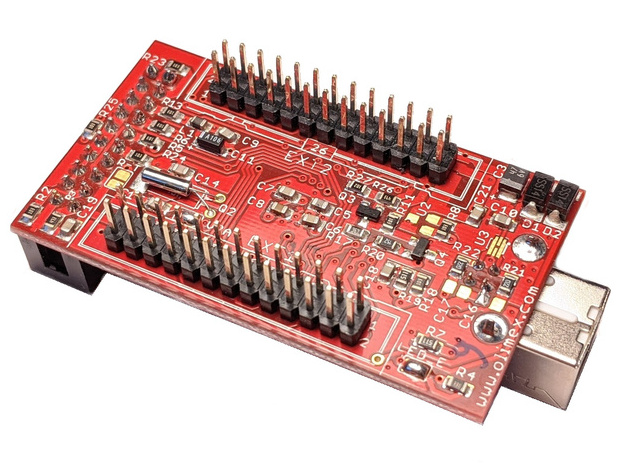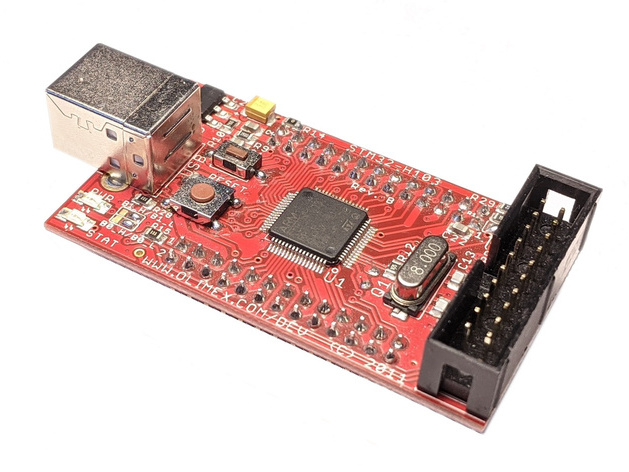OLIMEX-STM32-H103¶
Overview¶
The OLIMEX-STM32-H103 is a simple development board based on the STMicroelectronics STM32F103RBT6 ARM Cortex-M3 CPU, with all the MCU pins populated and accessible through two male 26-pin connectors.

OLIMEX-STM32-H103¶
Hardware¶
Information about the board can be found at the OLIMEX-STM32-H103 website and OLIMEX-STM32-H103 user manual. The OLIMEX-STM32-H103 schematic is also available.
The ST STM32F103RB Datasheet contains the processor’s information and the datasheet.
Supported Features¶
The OLIMEX STM32-H103 supports the following hardware features:
Interface |
Controller |
Driver/Component |
|---|---|---|
NVIC |
on-chip |
nested vectored interrupt controller |
SYSTICK |
on-chip |
system clock |
UART |
on-chip |
serial port |
GPIO |
on-chip |
gpio |
I2C |
on-chip |
i2c |
PWM |
on-chip |
pwm |
SPI |
on-chip |
spi |
USB |
on-chip |
USB device |
ADC |
on-chip |
adc |
Other hardware features are not supported by the Zephyr kernel.
Connections and IOs¶
Default Zephyr Peripheral Mapping:¶
UART_1 TX/RX: PA9/PA10
UART_2 TX/RX: PA2/PA3
UART_3 TX/RX: PC10/PC11 (not enabled)
I2C_1 SCL/SDA : PB6/PB7
I2C_2 SCL/SDA : PB10/PB11
PWM_1_CH1: PA8
SPI_1 NSS_OE/SCK/MISO/MOSI: PA4/PA5/PA6/PA7
SPI_2 NSS_OE/SCK/MISO/MOSI: PB12/PB13/PB14/PB15
USB_DC DM/DP/DISC/PWR: PA11/PA12/PC11/PC4 (not enabled)
ADC_1: PA1
System Clock¶
The on-board 8 MHz crystal is used to produce a 72 MHz system clock with PLL.
Serial Port¶
The board has 3 U(S)ARTs, UART1 and UART2 are enabled by default, with UART2 used as Zephyr’s console. Default settings are 115200 8N1.
On-Board LEDs¶
The board has one on-board green LED that is connected to PC12, which is active low.
There is also a red power LED neither connected nor controlled by the MCU.
On-Board Button¶
The board has one user button connected to PA0.
USB¶
USB is not enabled by default, however PC4 is configured by default as an ADC input to sense the USB voltage (see schematic). It is possible to disconnect it by desoldering the appropriate pad in the PCB.
The board uses PC11 to disconnect the pull-up resistor on the USB-DP line.
External Connectors¶
JTAG/SWD debug
PIN # |
Signal Name |
PIN # |
Signal Name |
|---|---|---|---|
1 |
+3.3V |
2 |
TVCC 3.3V |
3 |
PB4 / TRST |
4 |
GND |
5 |
PA15 / TDI |
6 |
GND |
7 |
PA13 / TMS / SWDIO |
8 |
GND |
9 |
PA14 / TCK / SWCLK |
10 |
GND |
11 |
NC |
12 |
GND |
13 |
PB3 / TDO |
14 |
GND |
15 |
RST |
16 |
GND |
17 |
NC |
18 |
GND |
19 |
NC |
20 |
GND |
EXTENSION 1
PIN # |
Name / STM32F103 Port |
PIN # |
Name / STM32F103 Port |
|---|---|---|---|
1 |
PA11 / USB_DM |
2 |
PA8 / PWM_1_CH1 |
3 |
PA12 / USB_DP |
4 |
PA9 / UART1_TX |
5 |
+3.3V |
6 |
GND |
7 |
PA10 / UART1_RX |
8 |
PC10 |
9 |
PC11 / USB_DISC |
10 |
PC12 / LED |
11 |
PD2 |
12 |
PB5/I2C1_SMBA |
13 |
PB6 / I2C1_SCL |
14 |
PA6 / SPI1_MISO |
15 |
PB7 / I2C1_SDA |
16 |
PB8 |
17 |
PB9 |
18 |
PA5 / SPI1_SCK |
19 |
PC0 |
20 |
PC1 |
21 |
PB0 |
22 |
PA7 / SPI1_MOSI |
23 |
VBAT |
24 |
PC13 |
25 |
RST |
26 |
PB1 |
EXTENSION 2
PIN # |
Name / STM32F103 Port |
PIN # |
Name / STM32F103 Port |
|---|---|---|---|
1 |
VDDA |
2 |
PC2 |
3 |
GNDA |
4 |
PA0 / BUTTON |
5 |
+3.3V |
6 |
GND |
7 |
PA2 / USART2_TX |
8 |
PA1 / ADC_1 |
9 |
PC3 |
10 |
PA3 / USART2_RX |
11 |
PA4 / SPI1_NSS |
12 |
PC4 / USB-P |
13 |
PC5 |
14 |
PB10 / I2C2_SCL |
15 |
P11 / I2C2_SDA |
16 |
PB13 / SPI2_SCK |
17 |
PB12 / SPI2_NSS |
18 |
PB14 / SPI2_MISO |
19 |
PB15 / SPI2_MOSI |
20 |
PC6 |
21 |
PC7 |
22 |
PC8 |
23 |
+5V USB |
24 |
PC9 |
25 |
GND |
26 |
VIN |
Programming and Debugging¶
This board does not include any embedded debug tool interface, instead you will have to use an external probe connected to the available 20-pin JTAG connector to progran and debug the board. Both JTAG and SWD are supported.
By default when using west debug ST-Link will be used with OpenOCD’s
SWD transport, but it is also possible to use JTAG with the Olimex ARM-USB-OCD-H
probe, for instance. For the latter, you should replace the file openocd.cfg
by openocd_olimex_jtag.cfg, located in the board’s support directory.
Flashing¶
Here is an example for the Button application.
# From the root of the zephyr repository
west build -b olimex_stm32_h103 samples/basic/button
west flash
Debugging¶
You can debug an application in the usual way. Here is an example for the Hello World application.
# From the root of the zephyr repository
west build -b olimex_stm32_h103 samples/hello_world
west debug
